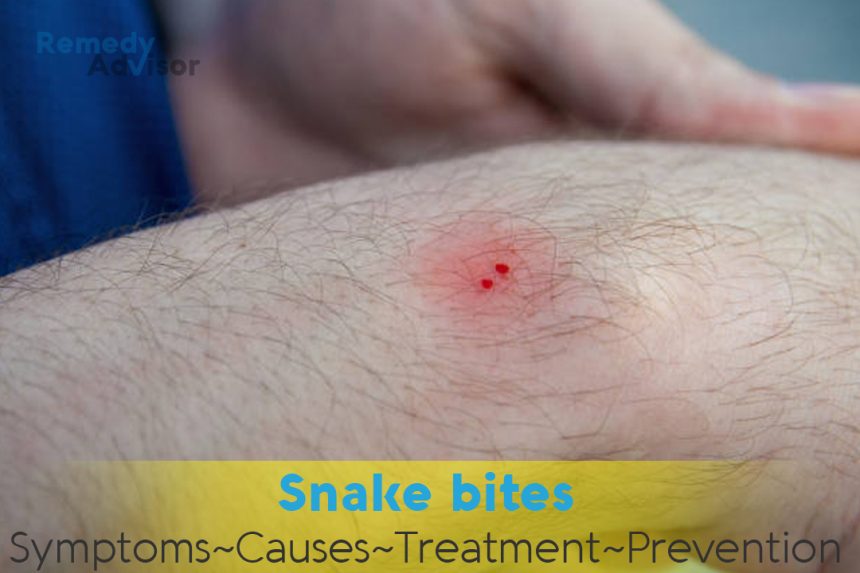What is it
Compared with other risks, such as injuries on the highway, getting bitten by a snake is a pretty remote possibility, unless you handle snakes regularly or camp out for long periods. Still, about 45,000 snake bites are reported every year in the United States; of these, only about 8,000 are venomous.
The bite of a poisonous snake can be painful and even fatal, and often requires hospitalization and treatment. Most poisonous snake bites are highly treatable, however fewer than 20 people die each year. The great majority of venomous bites occur in the southern states and in the Southwest, including California.
Symptoms
- A bite from a poisonous snake will leave a pattern of tooth marks topped by two fang puncture wounds.
- Symptoms of venom from a pit viper include pain and rapid swelling at the bitten area; dizziness; nausea; sweating; and numbness around the mouth.
- Symptoms of venom from a coral snake include pain at the bite site; drowsiness; slurred speech; double vision; nausea; sweating; and delirium.
What causes it
Rattlesnakes are responsible for two-thirds of the bites and almost all the deaths. Copperheads and cottonmouths (which, along with rattlesnakes, are known as pit vipers), imported snakes (kept by collectors), and the occasional coral snake account for the rest of the bites.
What if you do nothing
It’s important to get medical help at once if you’ve been bitten by a snake, even if the bite seems minor.
Emergency treatment
If you are certain the snake that bit you was non- venomous, the bite can be treated like any other animal bite. This may include a tetanus shot. Fortunately, you don’t have to be concerned about rabies from a snake bite.
If you’ve been bitten by a poisonous snake, or if you’re not sure what kind it was, get to the nearest emergency room, preferably with a companion, since you may quickly begin to experience pain and weakness if the snake did inject you with venom.
If you’re caring for a snake bite victim, keep the person warm and try to keep him or her calm. Remember that the most important task is finding medical assistance.
Before you reach an emergency room, follow these steps.
Never try to capture or kill the snake and take it along
That only wastes valuable time and puts you at risk of being bitten again.
Immobilize the bitten body part and keep it below heart level
If your foot or leg has been bitten, it’s a good idea to be carried, if there’s any way to arrange this. Try not to panic antivenins are available and effective.
Remove rings and other constricting items if the bite is on the hand or arm
Since most snake bite wounds will cause swelling.
Cleanse the wound, if possible
Use soap and water and cover the wound with sterile gauze or another clean dressing.
Do not apply ice
This can actually drive the venom deeper as well as damage tissue if it is left in place too long. Nor should you apply a tourniquet that shuts off the flow of arterial blood, as this can result in loss of the limb.
Use a constricting band only in very special circumstances
If medical help is more than half an hour away, and if not more than five minutes have elapsed since the bite, use a constricting band around a bitten arm or leg. Apply it two to three inches above the bite and tighten it so that you can still slip two fingers under the band. Check for a pulse below the band to make sure the blood is still circulating, and keep checking periodically. (Pulse points can be felt in the wrist and on the top of the foot above the instep.)
When to suck on a wound
Cutting a wound and sucking out the poison, once thought essential, should be considered only in extreme situations (for example, if you are hours away from any medical care). It should be done only if you have a suction cup, can start treatment within five minutes, and have had some training in the procedure.
And no matter what old-timers do in the movies, don’t give a snake bite victim a shot of whiskey or alcohol in any form.
Prevention
Preventive steps are by far the best “treatment” for snake bite.
Learn how to handle pets
If you or an acquaintance keeps snakes as pets, don’t handle them until you’ve had proper training. Never tease or hurt a snake.
Outdoors, stay back
If you see a snake outdoors, keep away from it Snakes try to avoid people.
Dress smart
If you’re out in the wilderness, wear long pants and footgear that covers your ankles. Thick gloves are practical, too, if you’re gathering firewood.
Be cautious
When turning over a rock or a fallen branch. Don’t reach or step into dark places, such as heavy underbrush. Make sure you can see what you’re getting into. Don’t put your hand into rocky crevices while climbing.
Stay in the clear
Camp in an open space and never gather firewood at night.







